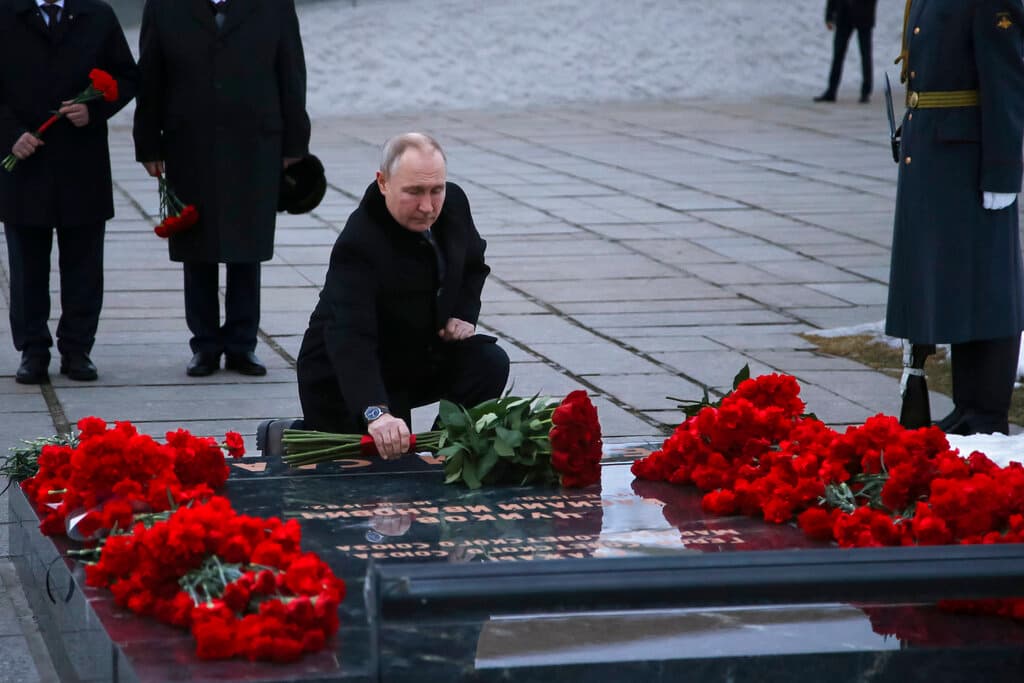Russia Mounts Human Wave Attacks To Win Ground in Time for War’s One-Year Anniversary
And, in a sign of the times, a new bust of Stalin is unveiled.

Without fanfare, Ukraine marked this week the deadliest day in Europe’s deadliest war since 1945. Ukraine’s Defense Ministry reports killing 1,030 Russian soldiers in one day — on Tuesday. The high death toll comes as Russia resorts to World War II-style human wave attacks in eastern Ukraine. Soldiers, largely draftees and convicts, are forced forward, often at gunpoint, with the goal of forcing Ukrainians soldiers to reveal their firing positions.
Behind this strategy are Russian generals desperate to provide President Putin with battlefield victories by the first anniversary, on February 24, of Russia’s all-out attack on Ukraine. Russia also is racing to advance before Ukraine receives hundreds of promised Western tanks and fighting vehicles. Despite high death tolls, Russia’s advances this winter have been measured in villages and hundreds of yards.
Ukrainian troops believe they already are resisting a big Russian offensive. Last week, Ukraine’s Defense Intelligence chief, Kyrylo Budanov, stated that there currently are 326,000 Russian forces fighting inside Ukraine. Finding more men will be a challenge for Russia. Britain’s Defense Ministry tweeted Tuesday: “It remains unlikely that Russia can build up the forces needed to substantially affect the outcome of the war within the coming weeks.”
On Thursday, the Putin-linked mercenaries, the Wagner Group, announced it is suspending recruitment of convicts. Last year, it recruited 40,000 prisoners with promises of amnesty. Reports of high death tolls in Ukraine filtered back to Russia’s far-flung prison archipelago. In recent weeks, Wagner recruiters have found few takers, according to an article in Mediazona, a Russian exile website.
In September, Mr. Putin’s declaration of an emergency military draft provoked a national backlash. An estimated half a million Russian men fled the country. Despite an economic recession, the number of Russians obtaining passports for foreign travel jumped by 40 percent last year, to 5.4 million, reports the Internal Affairs Ministry. The Russian government announced last week that it is halting the issuance of new passports for want of microchips.
To fill the ranks, the military is using an “invisible” draft — recruiting men without public campaigns. After 30 draft boards were burned, military recruiters turned to visiting employers directly. They also target minorities, far from spotlights of the press. The Nogai people, a 100,000-strong nation in the North Caucasus, have been heavily targeted, Nogai exile leader Anvar Kurmanakayev told Radio Free Europe’s Kavkav Realii website.
Desperate for recruits, Russia’s Defense minister, Sergei Shoigu, proposed last month making any Russian man in his 20s eligible for the draft. As a result, “highly qualified college graduates will not be able to enter the labor market and will instead end up in the military and lose their qualifications,” a fellow at the Carnegie Endowment for International Peace, Andrei Kolesnikov, writes. Meanwhile, he adds, “young men with vocational degrees who are already in the labor market will be torn from the economy partway toward improving their skills.”
Mr. Kolesnikov concludes: “The generation of 70-year-old Russian leaders is deciding for young people how they will live and what they will die for.”
Mr. Putin, who turned 70 in October, shows no signs of backing down. Last week in a speech at Volgograd, he evoked the sacrifice of Soviet soldiers who recaptured Stalingrad from the Nazis 80 years ago. After reviewing WWII-era tanks at a victory parade, he hailed “the indestructible nature of our people.”
Referring to Germany’s promise of battle tanks for Ukraine, Mr. Putin said: “Again and again, we have to repel the aggression of the collective West. It’s incredible but it’s a fact: we are again being threatened with German Leopard tanks with crosses on them.” In a separate ceremony, a new bust of Stalin was unveiled at Volgograd on February 1.
In the battle of Stalingrad, Soviet casualties totaled 1.1 million killed and wounded. There is no sign that modern Russian society will tolerate such high death tolls. During the first year of Russia’s full-bore assault on Ukraine, Russia’s casualties amount to 200,000 killed and wounded.
That estimate is according to American officials interviewed last week by the New York Times. This casualty toll could be as high as 270,000, calculates an independent investigative organization originally from Russia, the Conflict Intelligence Team. Ukrainian military casualties are believed to be at least 100,000.
For comparison, the Soviet Union suffered about 70,000 killed or wounded during its war in Afghanistan between 1979 and 1989. Of these, the official combat death toll was 14,453. By contrast, the Soviet population was 288 million in the late 1980s — double Russia’s population of 144 million today.
In four days of human wave attacks, the Ukraine Defense Ministry reported that Russia had lost 3,720 soldiers, raising Russia’s death toll to 135,010 for nearly one year. Putin may believe that his rule can survive losing 10 times the Afghanistan death toll, yet Afghanistan was traumatic for the 15 republics of the Soviet Union.
Today, throughout the former Soviet Union, virtually every major city has a stone memorial to the Afghantsi — the men who died pursuing Moscow’s imperial designs on a neighboring nation. Toward the end, in 1988, separatist movements started to emerge in the Baltics, the Caucasus, and in Ukraine. On February 15, 1989, the last Soviet column drove out of Afghanistan. On December 26, 1991, the Soviet Union collapsed.

